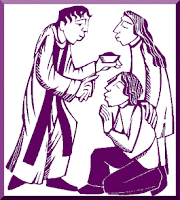What Happens to Palm Sunday Palms?
Q: What do we do with left over palm branches after Palm Sunday?
 A: We find differences among those church bodies that follow a liturgical calendar and observe Palm Sunday. Even within the same body, regional and congregational differences exist. Often used in choir or children’s processions at the beginning of the first service of Holy Week, the palms may be sent home as mementos of the day, either to all congregants or else to only the young people.
A: We find differences among those church bodies that follow a liturgical calendar and observe Palm Sunday. Even within the same body, regional and congregational differences exist. Often used in choir or children’s processions at the beginning of the first service of Holy Week, the palms may be sent home as mementos of the day, either to all congregants or else to only the young people.Other congregations merely gather them and dispose of them after church. While most of these churches try to find a reverent means of disposal, others haul them out with the rest of the trash.
An ancient practice followed in much of Christianity involves gathering whatever branches are not taken home. These are usually dried as completely as possible and are then burned in “clean” receptacles that are free of refuse, burnt food waste, and the like. The burning is conducted carefully so the ashes remain and do not fly up and blow away.
After being burned and cooled, the ashes are carefully sifted to remove any remaining bits of branch or unburned leaves — especially the thorny tips common to certain palms. The remnant may be further ground before the ashes are gathered and set aside until the following Lenten season. On Ash Wednesday, they are used in a ceremonial imposition of ashes upon the foreheads of those coming to church.
 Ash Wednesday receives its name from the ancient practice of placing ashes on the foreheads of Christians to mark the beginning of the Lenten fast. Liturgical churches usually use part of Matthew 6 as the Gospel of the day. In this portion of the so-called “Sermon on the Mount,” Jesus differentiated between the proper and improper practice of three major spiritual disciplines. These are almsgiving, or helping the poor (vv. 1-4), prayer, (vv. 5-6), and fasting (vv. 16-18).
Ash Wednesday receives its name from the ancient practice of placing ashes on the foreheads of Christians to mark the beginning of the Lenten fast. Liturgical churches usually use part of Matthew 6 as the Gospel of the day. In this portion of the so-called “Sermon on the Mount,” Jesus differentiated between the proper and improper practice of three major spiritual disciplines. These are almsgiving, or helping the poor (vv. 1-4), prayer, (vv. 5-6), and fasting (vv. 16-18).Normally, the palm ashes are soon removed and are not reapplied. This is in line with Jesus’ words on fasting: “When you fast, do not look gloomy like the hypocrites, for they disfigure their faces that their fasting may be seen by others. (Matthew 6:16)” Even though many of us fast during Lent, we try to make our fasting as inconspicuous as possible. We aren’t putting on a show for others but are rather humbling ourselves before the Lord: “When you fast, anoint your head and wash your face, that your fasting may not be seen by others but by your Father who is in secret. (vv. 17-18)”
Scripture quoted from The Holy Bible, English Standard Version™, © 2001 by Crossway Bibles.
Send email to Ask the Pastor.
Walter Snyder is a Lutheran pastor, conference speaker, author of the book What Do Lutherans Believe, and writer of numerous published devotions, prayers, and sermons.
Technorati Tags: Lent | Palm Sunday | Passion Sunday | Sunday of the Passion | palms | palm branches | ashes | Ash Wednesday | Church year | Christian year | Christian calendar | liturgical calendar | liturgics | liturgical theology | Pastor Walter P. Snyder | Walter Snyder | Ask the Pastor
Newspaper column #586:1

0 Comments:
Post a Comment
<< Home